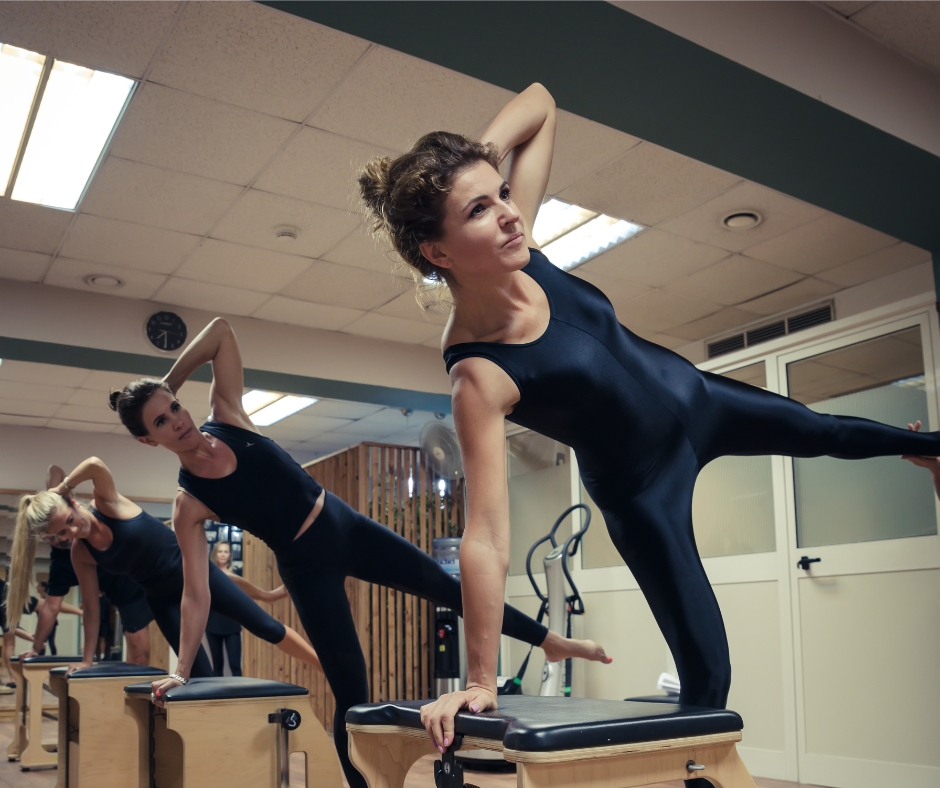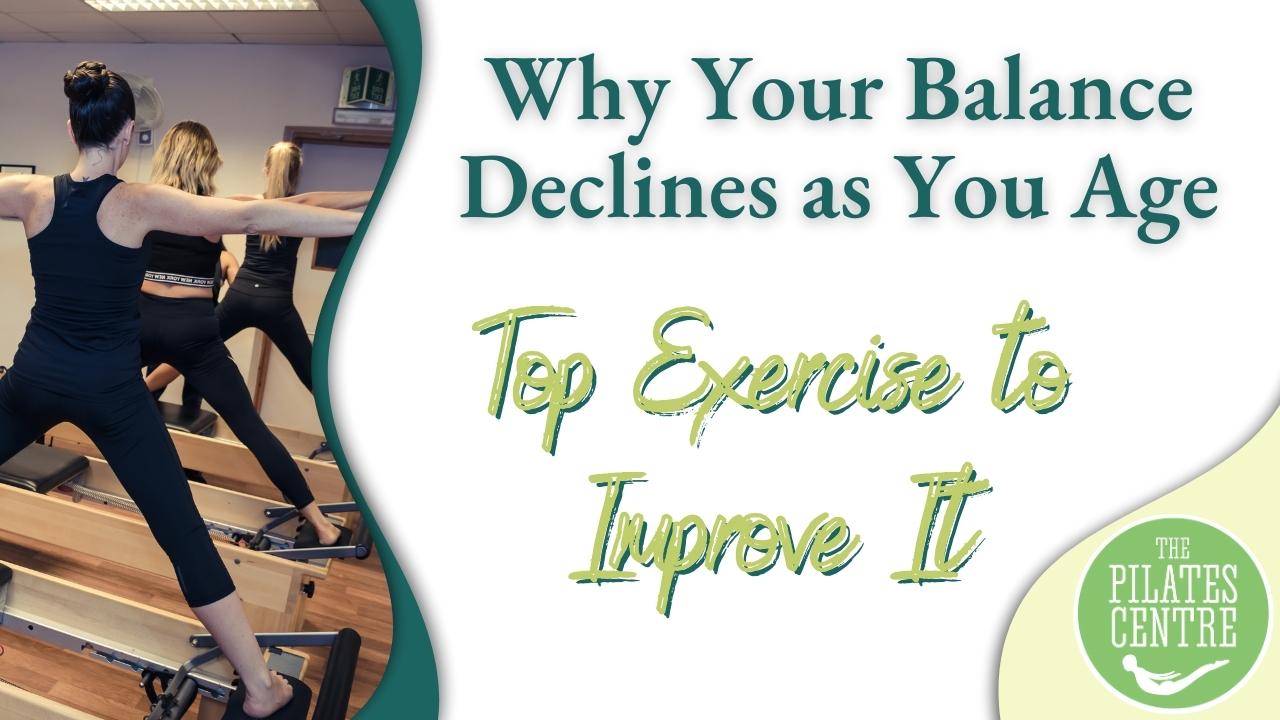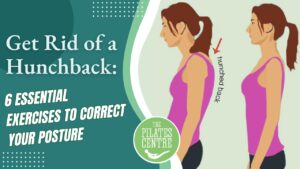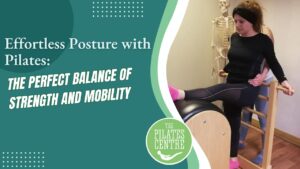Introduction
As the years pass by, it’s not uncommon to notice a gradual decline in your balance. Whether you’ve experienced a moment of unsteadiness when rising from a chair or felt a tad wobbly while navigating a flight of stairs, you’re not alone. Balance-related issues are increasingly prevalent among older individuals. Maintaining good balance is vital for daily activities such as walking, climbing stairs, or getting in and out of a car. It’s an essential element for retaining independence in your later years. Unfortunately, balance problems often lead to falls in the elderly, with one in four older Americans experiencing a tumble each year, and a significant portion of these falls resulting in severe injuries.
But why does our balance falter as we age? In this article, we’ll explore the reasons behind this decline and introduce you to five Pilates-inspired exercises to enhance your balance and maintain your stability as you grow older.

6 Reasons Balance Worsens With Age
- Loss of Muscle Mass: Aging brings about the gradual loss of muscle mass, a process known as sarcopenia, which can commence as early as age 30. This loss results from a combination of factors such as increased inactivity and hormonal changes. Weakening muscles can compromise joint stability, a critical element in maintaining good balance.
- Decline in Joint Mobility/Flexibility: Leading a sedentary lifestyle in your senior years can affect your joint health. Prolonged periods of sitting or lying down can lead to tight and inflexible muscles and joints, reducing your ability to move effectively. Arthritis and bone-related diseases, common in older individuals, can further limit joint mobility.
- Diminished Proprioception: Decreased physical activity in older age can diminish your proprioception, your body’s awareness of its position. This ability is crucial for maintaining balance, as it allows you to sense the position of your joints and body. Without it, maintaining equilibrium becomes a challenge.
- Slowed Reflexes: Reflexes, which are automatic reactions to various stimuli, are crucial for coordination, balance, posture, and movement. These reflexes tend to slow as you age, primarily due to inactivity and age-related changes in the nervous system.
- Degeneration of the Vestibular System: Your vestibular system, responsible for balance, can deteriorate with age. Its health is influenced by various factors, including inflammation and metabolic regulation.
- Impaired Vision: Aging is often associated with an increased risk of eye diseases that can affect your balance. Vision plays a significant role in maintaining equilibrium, and age-related changes in vision can impact your balance abilities.
6 Pilates Routine for Improved Balance
If you find floor-based Pilates challenging, consider a standing Pilates workout designed to enhance your balance. Here are some Pilates inspired exercises that use only your body weight to help you find balance. These exercises can be adjusted to match your fitness level and accommodate any fatigue you may experience.
As you build your strength and balance and wish to progress further, you can incorporate light weights or the Pilates Magic Circle. your plank position closer to the floor (like placing your hands on a cushion rather than a table) or aim for a 1-minute plank hold.
1. Body Weight Squats
Air squats replicate movements you perform daily, such as rising from your couch or sofa, or squatting to pick up something from the floor or crouching down to pet your dog. These squats help maintain strength and stability as you age. Bodyweight squats are an excellent exercise for strengthening the legs and glutes, whilst promoting flexibility and strength in the ankle joint. The stronger and more flexible we are, the better our balance will be.
Top tips: Keep your feet hip width apart and keep a long spine. Do not tuck you tailbone and push with your heels to come up. Keep the knees in the same line as your second toes and behind your feet.
To advance: You can go further down into the squat to try and to below your knees so your glutes are closer to your heels.
2. Wall plank / push ups
This is a great initial step to create core and upper body strength. The first part is to keep the exercise static (meaning without moving your body), and elbows in line with your shoulders. You can hold for up to a minute.
Then slide hands down, in line with your shoulders and initiate the push ups.
Top tips: Keep your elbows in, skimming your ribs as you bend them. Keep an external rotation in the upper arm and shoulders away from your ears. Pull your stomach in and lengthen you tailbone. People who have hyperlordosis of the lower back should look at bringing their tailbone under so that their pelvis comes in line with the ribs. Pull your stomach in and lengthen from the crown of your head.
To advance: You can go on your tip-toes or even take it to the ground on a mat.
3. Chair / Bed Plank
The plank exercise targets your core muscles, promoting stability and reducing the risk of falling when balance is lost. Start with your feet close to the chair or bed and gradually moving your feet backward as you become stronger. Eventually, you can lower the exercise to the ground.
Top tips: Keep your elbows under your shoulders and shoulders away from your ears. Push off with your forearms into the chair / bed so you are not sinking into the shoulders. Pull your stomach in and seek to create a long line from your head to your heels, looking for opposition.
To advance: Lower your plank to the ground on a mat, keeping the integrity of the exercise. You can also try to place your hands on the mat, instead of the elbows, ensuring to keep wrists under shoulders.
4. Standing Heel Raises
This exercise is designed to bolster ankle strength and stability, which are vital for improved balance. As you progress, you can attempt Pilates prances, lifting one heel at a time and alternating sides.
Top tip: Hold on to something, whilst maintaining a straight back, with your hands at waist height for initial stability.
To advance: Take your hands off and do the same exercise without holding on. If you want to advance further try closing your eyes, making sure you have something stable close by, in case you lose balance.
5. Standing Side Planks
This is a great balance builder that strengthens the core and enhances ankle stability. It involves standing on both feet, ultimately helping to stabilize your ankles.
Top tips: Keep your hand in the same line as the shoulders and shoulders away from your ears. As you bend the elbows, try to get them to touch the side ribs, then push off with your hands against the wall, engaging your abs.
To advance: Once you’ve mastered the standing side plank with proper form, consider trying it while balancing on one leg for an added challenge.
6. Knocking on Heaven’s Door
This take on the Spine Twist from Pilates is actually caught from Adriene Mishler‘s Yoga and is a great way to release any blocked energy or tension for the spine whilst keeping the lower body stable, thus challenging your stability.
Top tips: Keep your feet hip width apart and knees slightly bent as you sway your body side to side and moving your arms with you. Engage your abs and firmly anchor your feet and connect to your seat for core stability.
To advance: Go faster and start tapping your back with the arms, straightening the legs.
By incorporating these exercises into your routine, you can take proactive steps to improve your balance and maintain your stability as you age.
Conclusion
The natural aging process need not mean surrendering your balance. By understanding the reasons behind declining balance and actively engaging in Pilates-inspired exercises designed to promote joint mobility, stability, strength, and proprioception, you can enjoy improved balance and a more stable, confident life as you grow older. Don’t let age stand in the way of your ability to stay upright and active. Embrace these exercises, and empower yourself to age gracefully, with grace and stability.
To learn more about Pilates Centre or if you’re interested in our sessions, you can email us at info@pilatescentre.es. If you have any questions, feel free to reach out to John and our team at +34 610 30 60 05. We are more than happy to assist you.

John McCallum
is an esteemed, Fully Certified Comprehensive Classical Pilates Teacher and takes immense pride as the proprietor of the distinguished Pilates Centre located in Jalon, Spain. His remarkable journey in the realm of Pilates commenced back in 2006, a pivotal juncture when he confronted the diagnosis of three slipped discs in his lower back. Pilates emerged as a beacon of profound hope and rejuvenation in his life. Instead of succumbing to the prospect of surgical intervention, Pilates gracefully assumed the role of his lifeline.
This transformative experience impelled him to make a resolute decision that would reshape his life’s trajectory. Following his journey to become a Pilates Teacher, he passionately extended the benefits he had personally garnered to those in need. This also took him to travel to other countries to continue to learn and have a fuller understanding of the method.
Fueled by an unwavering passion for Pilates, he has forged a dynamic collaboration with a reputable research institution. This strategic alliance enables him to deliver precise and illuminating insights, fostering support and empowerment for individuals interested in the power of this method. His literary contributions have garnered distinction within an array of esteemed global publications.




